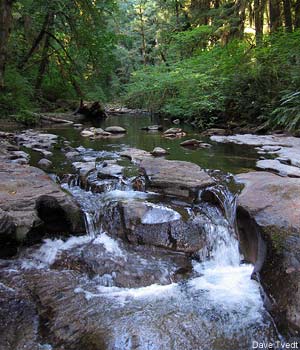Protecting the Devil's Staircase
Oregon's Coast Range, which runs south from the Washington border, is home to what many consider the single most remote location in the entire state.
In the 1970s, the very existence of the Devil's Staircase was hotly debated. Some thought rumors of cascading pools carved into the sandstone like a staircase were only myth. Others were convinced the waterfall existed, but didn't know where along the unbelievably rugged miles of Wassen Creek it could be found.
Volunteers hunted in vain for Devil's Staircase for several years, but eventually it was located.
Nearly three decades later, there is still no route—not a single trail—into the area. To reach this amazing wild place one must try to follow elk and deer trails, hike the creek bed, or go overland through impossibly rugged terrain.
Wassen Creek runs through public land, managed by the U.S. Forest Service and the Bureau of Land Management. Logging and road-building have been prohibited since adoption of the Northwest Forest Plan in 1994. Today this area has one of the finest stands of old-growth ancient forest in Oregon's Coast Range, inhabited by spotted owls, elk, black bear, mountain lions, otters and other wildlife.
 In October, 2008, Rep. Peter DeFazio (D-OR) became the first member of Congress to make the eight-mile trek to the Devil's Staircase. The staircase, and the arduous trip to locate it, lived up to its reputation. The Congressman was so impressed that he vowed to protect the area with federal legislation.
In October, 2008, Rep. Peter DeFazio (D-OR) became the first member of Congress to make the eight-mile trek to the Devil's Staircase. The staircase, and the arduous trip to locate it, lived up to its reputation. The Congressman was so impressed that he vowed to protect the area with federal legislation.
Pew's Campaign for America's Wilderness commends Rep. DeFazio and Sens. Ron Wyden (D-OR) and Jeff Merkely (D-OR) for introducing legislation to protect nearly 30,000 acres of wilderness around Devil's Staircase and seven miles of Wassen Creek as a Wild and Scenic River.






